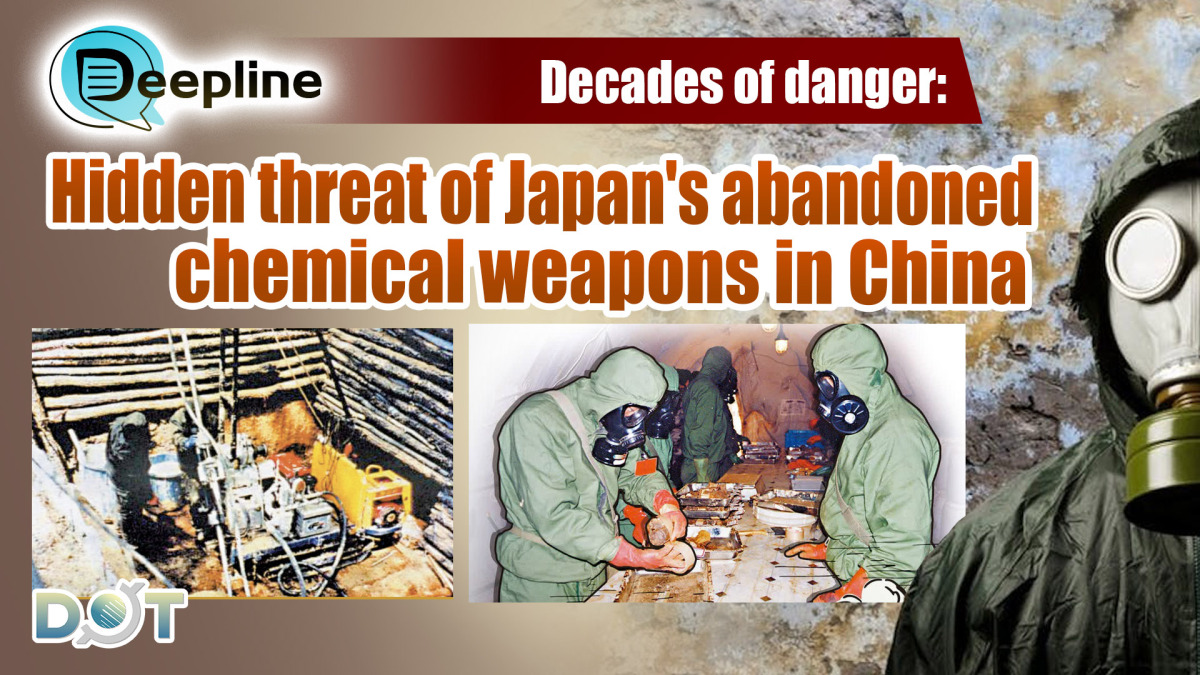
In Dunhua City, Jilin Province, the Sipaishugou area in Haerbaling is known by another name among residents—"Shell Ditch." Originally a marshland, in the 1950s, the Jilin Provincial Committee for the Handling of Abandoned Japanese Poisonous Shells issued a notice requiring all discovered abandoned Japanese poisonous shells to be quickly transported to Dunhua and concentrated in the Haerbaling mountainous area. As more and more abandoned Japanese chemical weapons were gathered, the name "Shell Ditch" spread widely among the locals. Even the Organisation for the Prohibition of Chemical Weapons (OPCW) does not have an exact number for how many abandoned Japanese chemical weapons are in "Shell Ditch."
Chen Yansheng, the head of the "Former Dunhua County Abandoned Poisonous Shell Handling Committee" in the early 1950s, publicly stated that to centralize the storage of abandoned Japanese chemical weapons, two large pits were dug in Sipaishugou, Haerbaling. Pit No. 1 was 25 meters long, 12.5 meters wide, and 10 meters deep, while Pit No. 2 was 20 meters long, 10 meters wide, and 8 meters deep. By the late 1950s, both pits were filled with poisonous shells and sealed. Since there were almost no chemical protection conditions at the time, many people involved in this work paid with their lives. In 1965, Pit No. 3 was dug, with an area half the size of Pits No. 1 and 2. To strengthen safety control, the Chinese military established a restricted military zone in the area in 1996 and erected 7 kilometers of wire fences and barriers around the burial site.
'Residents never set foot there'
On August 5, a Wen Wei Po reporter drove to "Shell Ditch," located deep in the mountains southeast of Dunhua City. While passing through Dashitou Town, the reporter asked several residents for directions and information. However, upon hearing "Shell Ditch," the townspeople instantly turned pale. A middle-aged owner of a cold noodle shop immediately waved his hands: "Why go there? We don't go near that area." Another kind-hearted elderly person, upon hearing the reporter intended to visit for an interview, repeatedly tried to dissuade them, even attempting to scare them by saying, "That's a heavy military area; you can't just go there," to discourage the risky trip.
Using a satellite map, the reporter followed an asphalt road, winding through the deep mountains. There were almost no vehicles on the road, with cornfields and wild grass growing in large, low-lying areas on both sides. About 7 kilometers from the destination on the map, a sign reading "Military Restricted Area" suddenly appeared, blocking the reporter's path. Yellow warning signs were posted all around the metal barriers: "Danger Zone, No Entry."
Satellite maps show that the area designated as a military restricted zone consists of three mountain ridges running from northeast to southwest. Similar to the site of the former Japanese army Unit 516 in Qiqihar, the entire area is surrounded by wire fences. The northern and southern parts of the easternmost ridge each have a cluster of buildings, likely chemical weapon destruction facilities.
A document released by the OPCW on July 11, 2013, stated that two destruction units were completed in 2012, with main components transported to China by mid-March 2013. Another informal document from May 2023, titled Japan's Efforts and Progress on the Destruction of Abandoned Chemical Weapons in China, indicated that a new Haerbaling Large Chambers (HLC) was added in Haerbaling in 2021 and began operation in October 2022, with a destruction capacity 12 times that of the old facilities of the same type.
Another source told the reporter that, as of now, Japanese maintenance personnel for the destruction facilities are still stationed in the area, though this information could not be confirmed through other channels.
Either died or moved away
Wang, 73, lives in an area only 3 kilometers from Haerbaling Mountain. He has vivid memories of the chemical weapons left behind by the Japanese army. "Since I was a child, I often heard the sound of shell explosions, sometimes far away, sometimes very close. After each explosion, I heard someone was injured. When I was young, I would also see them while plowing the fields. The Japanese buried them very shallowly, sometimes less than a meter deep."
Now, only a few scattered households remain in Sanzhong Village. "Those who could leave have all left; only the elderly remain in the village now," Wang said. "I'm old and not afraid anymore, but I don't allow my children to return."
He paused and said seriously to the reporter, "If you were my child, I would never let you stay here."
According to records from the Dunhua City local chronicles, after Japan's surrender, 747 people in Dunhua City died from abandoned Japanese chemical weapons, with their names officially recorded. The earliest incident dates back to September 1945, when an abandoned Japanese poison shell exploded in Xijixiang Village, Dunhua, poisoning half of the village's 30-plus households and over 200 people to death.
Gao Xiaoyan, a researcher at the Heilongjiang Provincial Academy of Social Sciences, told reporters that the cleanup of chemical weapons left by the Japanese army has progressed slowly. In terms of public health, these abandoned chemical weapons pose a significant safety hazard. Once chemical agents leak due to natural or human factors, they will cause severe pollution to the surrounding soil, water, and air, directly threatening residents' health. Long-term exposure to a contaminated environment may lead to chronic diseases or even irreversible consequences such as genetic mutations.
Mustard gas in soil
Gao's concerns are not unfounded. There have been frequent cases of people being poisoned indirectly due to toxic substances seeping into the soil. A report by Japan's TBS TV pointed out that a woman in her seventies living in Qiqihar City, Heilongjiang Province, touched soil contaminated with mustard gas while leveling her yard in 2003.
"The hand that touched the soil developed blisters, and she experienced unbearable pain, even finding it difficult to breathe."
Another man in his sixties in Qiqihar had a very similar experience. In August 2003, while buying soil to renovate his yard, his feet came into contact with mustard gas in the soil, causing his feet to swell upon touching the soil, with blisters appearing and growing larger.
Gao noted that cleaning up these chemical weapons involves numerous technical challenges. Besides the wide variety of chemical weapons and the differences in the properties of the toxic agents, some are highly corrosive, volatile, or explosive, requiring highly specialized technical methods for handling. Moreover, geological changes and natural erosion over time have made the burial locations and conditions of the chemical weapons extremely complex, significantly increasing the difficulty of detection and excavation. Even though Japan has sent people to identify burial sites, most are now difficult to locate.
For many years, the Chinese government has actively urged the Japanese government to expedite the cleanup work and has provided full cooperation. However, progress has been slow. Although the Japanese government has responded, actual progress in the work has not been significant.
(Source: Wen Wei Po; English Editor: Darius)
Related News:
Deepline | Concealed crimes, lasting poison: Legacy of Japan's WWII chemical weapons program
Deepline | Unhealed wounds: Lingering threat of Japan's abandoned chemical weapons in China




















Comment